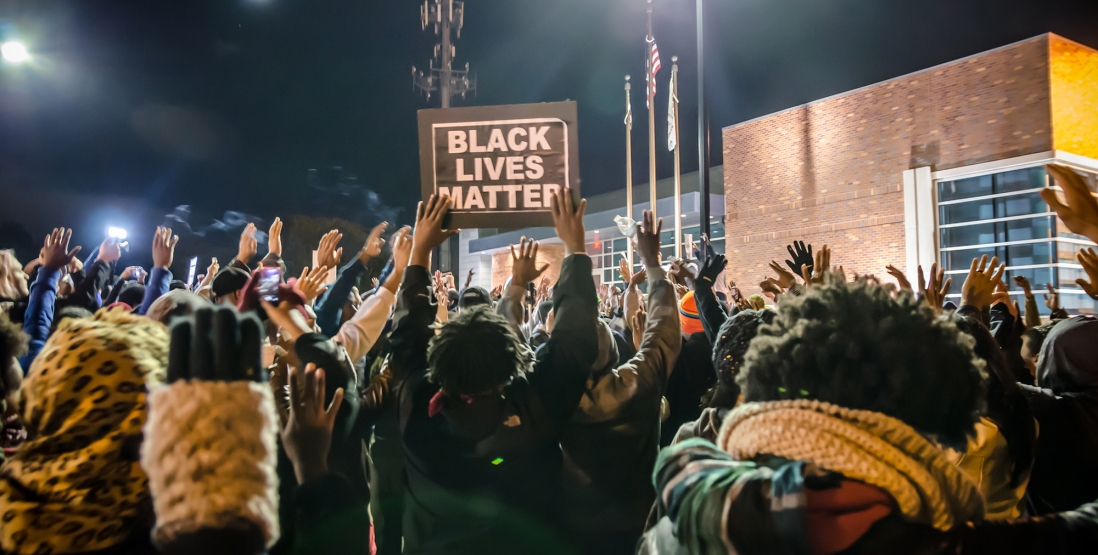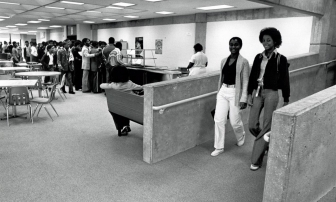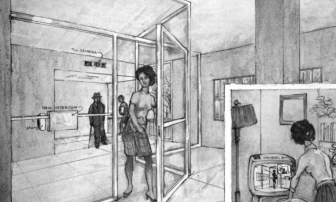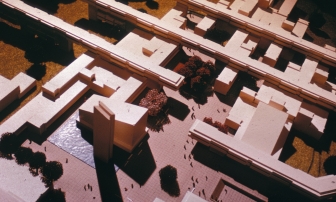Is “Justice Architecture” Just?
Protest at Police Station in Ferguson, Missouri. October 12, 2014.
Photo by Sarah Ji.Shortly before protest erupted in Ferguson, Missouri, over the death of Michael Brown at the hands of police officer Darren Wilson, the City of Ferguson designed an addition to their police station. Now that the entire nation is familiar with the role of the Ferguson police department in funding city services controlled by a majority-white city council through issuance of tickets to the city’s predominantly black majority, perhaps the addition of a dispatch center and a new courtroom at the police station no longer seems like a neutral project.
The police station project wasn’t discussed at the AIA (American Institute of Architects) Academy of Architecture for Justice (AAJ) conference that occurred, coincidentally, in October 2014 at the downtown Hilton St. Louis hotel, but the Buzz Westfall Justice Center where prosecutor Robert McCulloch’s grand jury met to exonerate Wilson was featured in a building tour. The combined courthouse, office, and county jail complex—more a bread-and-butter civic building than a high-design product—was a typical fit for the conference: AAJ is the networking group for AIA member architects whose clients include police departments, county sheriffs, courts, and corrections departments. The conference showcased the design of police stations, courthouses, jails, and prisons, and included a small expo floor featuring wheelchair lifts (for courthouses) and surveillance systems, detention-quality door and window hardware, and prefabricated jail and prison cell manufacturers (who work in either steel or concrete).
AAJ’s 2014 theme of “Social Justice” was a welcome nod of recognition within the field of “Justice Architecture” lately dominated by jail and courthouse construction, but if the Ferguson police station is any guide, architecture as a profession has a long way to go to address the pressing social and racial justice concerns of the Black Lives Matter movement.1 But where to start? Taking race at face value, one could note that attendance at AAJ was almost entirely white, largely male, and mostly over 40. In this, AAJ reflects the problematic lack of diversity within AIA (and the larger American architectural profession).2 As is tragically common at architectural events I have recently attended, the only people of color in the room were service workers in the conference hotel (I am a white man).
My role at the AAJ conference was to represent the perspective of Architects/Designers/Planners for Social Responsibility (ADPSR), an independent nonprofit organization that launched the “Prison Design Boycott for Alternatives to Incarceration” campaign in 2003, and in 2012 petitioned AIA to prohibit the design of execution chambers and spaces for prolonged solitary confinement in their Code of Ethics.3 We bring a critical perspective to AAJ, arguing that the quality of design for a prison or jail is of secondary importance when the people inside are unjustly incarcerated in the first place. Our analysis of the racial injustices of mass incarceration is informed by Michelle Alexander’s The New Jim Crow4 and Loïc Wacquant’s “Class, race & hyperincarceration in revanchist America,”5 which taken together outline a history in which the legal, racialized segregation of the pre-Civil Rights era was replaced with the “tough on crime” explosion of prisons, jails, police, and criminal penalties to trap poor people of color in ghetto neighborhoods.6 We believe that the mean-spirited and punitive nature of the US criminal justice system overall is itself an unacceptable injustice, from stop-and-frisk to mass incarceration. We chose to challenge the design of execution chambers and spaces for prolonged solitary confinement (among other forms of torture), because these are the harshest pieces of the larger system of injustice, they are frequently identified as clear examples of human rights violations, and the design of spaces is where we participate in the criminal justice system in our role as architects. In rejecting these most extreme practices, we have always sought to contextualize them within the role of more conventional prisons, courts, and police in oppressing poor communities of color.
ADPSR has long argued that what is needed to redress mass incarceration is not better prison design, but better community design, and especially funding for community development. Despite our role as architects and planners, or rather because of it, we are well aware that design is less than 10 percent of the cost of most new buildings. We believe that as predominantly white, relatively privileged professionals with close access to property developers and planning agencies, architects and planners have a responsibility to advocate for an increased share of public and private investment in underserved neighborhoods. We believe that poor communities of color don’t need more policing, but rather more investment in buildings and a public realm that supports the kinds of positive street life and community involvement that lead to safety, individual growth, and shared prosperity.7
Of course, it is the closeness of architects and planners to the rich and powerful—in fact, our need to be close in order to win contracts—that makes so many of us unwilling to challenge the gross inequities of the status quo. AIA’s letter rejecting ADPSR’s proposal to prohibit the design of spaces intended for killing and torture, which had letters of support from Amnesty International, Human Rights Watch, and the UN Special Rapporteur on Torture, cited the “potential of antitrust challenges to such a rule” as a significant concern.8 This kind of smokescreen argument tried to obscure what one AAJ member was honest enough to say in a committee meeting in New York in 2013: Refusing to design the solitary isolation component of jails and prisons would put AIA firms at a disadvantage in pursuing conventional “Justice Architecture” projects. At the same time, many AAJ architects at the 2014 conference told me that they appreciate ADPSR’s advocacy. Apparently, if someone else can change government priorities from funding jails to rebuilding public housing or doing parks and playgrounds for poor communities of color, AIA architects will go after those contracts, too.
A popular notion within the sphere of humanitarian and public-interest design is that everyone deserves architecture and design, even if they can’t afford to pay for professional services. In particular, poor people of color deserve not only affordable housing (to name just one need), but also well-designed affordable housing. A related theme is that for architecture to truly embrace a diverse clientele, we must become a diverse profession that can relate to the lived experiences of poor as well as middle- and upper-class communities, even as our work almost inevitably changes the lifestyle of poor occupants. But in the face of the gross injustices dealt out to people of color every day and the history of racialized oppression that has changed form many times but is still far from over, perhaps these notions of inclusion and diversity, noble as they are, are not enough. ADPSR’s history dates back to the early 1980s, when it was founded to protest the potential destruction of all human civilization via nuclear weapons during Ronald Reagan’s escalation of the Cold War. We still believe that nonviolent conflict resolution is an underutilized human capacity and that violence itself is generally the problem. Translating ADPSR’s activism from the peace movement that challenged the 2003 US invasion of Iraq to the “war on drugs” and “war on the poor” at home was not a stretch. While much focus of humanitarian designers has been on post-disaster and post-conflict situations (where assistance is certainly needed), the opportunities to serve poor communities at home are just as deserving, if not more so. Indeed, with our domestic “wars” having used poor communities of color as battlefields, it’s not a stretch to apply humanitarian post-conflict rebuilding impulses to our own cities and towns.
Despite its old-fashioned ring, it’s still true that the levels of community investment needed for our poor communities of color to live in dignity could easily be provided (without tax increases) if defense spending was significantly cut—the so-called “peace dividend” that was never realized despite the end of the Cold War. In the same vein, we could also cut prison and police spending back to the levels before our domestic “wars” began and reinvest those funds in the schools and other community services that have been cut to make way for being “tough on crime” through Justice Reinvestment.9 The argument has been made so many times that there’s no need to cite the facts and figures here, and its importance rests on more than financial calculations.10 The cost of living in a society dominated by militarism and fear cannot be measured by dollars alone, nor should one avoid doing the right thing simply because it may be expensive.
A final point of reference is Jonathan Simon’s Governing Through Crime,11 which relates the shifting tides of American jurisprudence to evolving archetypes of the American citizen whom government is meant to serve, from Jeffersonian yeoman farmers to postwar unionized workers and beyond. The “tough on crime” frame that has come to dominate criminal law in recent decades also governs school and workplace discipline and even family law, and comes from a polity that perceives itself as threatened and vulnerable. Simon observes the outcomes not only in school design (more visibly “secure” schools are a feature of the school-to-prison pipeline), but also in the segregation of the residential real estate market. It is unmistakable that young black men (along with Muslims) are the stereotype for what threatens the white American majority, although statistics clearly show that larger threats come from other quarters, from financial fraud to traffic accidents and chronic disease. Black Lives Matter challenges this basis for policymaking, replacing the pseudo-victimhood of aggrieved white voters with the real victimhood of people of color. The movement insists on equality, and more.
Simon opens the question of what governance would look like if it were aimed at serving the needs of America’s entire diverse population: What if every American were truly considered of equal importance? The public-interest design movement has engaged this question as well, asking what we would design if we viewed every member of society as equally important clients. ADPSR approaches this question from a human rights perspective, noting that the 1948 UN Universal Declaration of Human Rights recognizes rights to housing, education, and medical care—all of which require the design of suitable buildings as a necessary (though not sufficient) condition for their realization.12 The human rights connection is important: Michael Brown’s parents traveled to Geneva, Switzerland, to file a claim that their son’s human rights had been violated in his police-caused death. By the same token, the failure of the State of Missouri and the US government to respect the human rights of people of color in law enforcement interactions is part and parcel of their failure to care about the lack of dignified housing and other social services for entire poor communities of color.
The Universal Declaration of Human Rights includes the principle of indivisibility—people and governments cannot pick and choose which rights to respect (even though in practice the United States has written reservations to some rights in the document and, although with most other countries, manifestly fails to uphold many others). The right to housing and an adequate standard of living cannot be separated from the rights to security of person, equal protection of the law, and freedom from arbitrary detention.13 And indeed, it’s hard to find any place where poor people with substandard housing are not subjected to police intimidation and abuse; the realization of the international human rights system is that we must not only end police abuse and intimidation (among other civil rights violations), but also provide a life of dignity (i.e., economic rights) for every member of society as well.14
Advocates of human rights have always realized that we are in for a long struggle, and that it proceeds in more and less visible moments. The advent of Black Lives Matter has raised the visibility of abusive policing, but the solutions to police killings are not only, or even primarily, in body cameras or the training of police officers. The racism underlying police abuse is a general feature of American society, and it can only be replaced by increasing respect for all human beings and their human rights, with all the profound implications of dignity, equality, and tolerance that demands. Ending our criminal justice system’s war footing and realizing our peace dividend through Justice Reinvestment would bring with it a huge amount of post-conflict rebuilding work for architects and planners in our ghetto neighborhoods, with a tremendous supply of projects available in virtually every metropolitan area around the country and most rural ones as well. In order to welcome these projects, architects and planners must advocate for the human rights of the individuals and communities that our work would serve—human rights are indivisible. Architects and planners can find a role to play in enhancing respect for black lives and human rights, or remain the decorators of real estate bubbles so many of us are today—that is the choice we face after Ferguson.
✓ Not peer-reviewed
Raphael Sperry, “Is ‘Justice Architecture’ Just?,” Aggregate 3 (March 2015), https://doi.org/10.53965/YXMN4181.
- 1
Conference themes can also be thin veneers over “business as usual.” At AAJ’s 2012 conference in Toronto, Ontario, themed “Community Dialogue,” organizers refused to allow Toronto community members who had opposed construction of a large new jail in the city to attend the panel session that celebrated the project’s design and construction process.
↑ - 2
While obviously insufficient, AAJ’s steps toward valuing diversity are worth noting: The conference paid for four “emerging professional scholars” to attend (to improve age diversity), and the conference program included some prominent African-American speakers and even a local chapter of YouthBuild U.S.A., all young African-Americans, to bring some faces of color. One should also note that AAJ’s leadership group of five is composed of four women, one of whom is Asian-American, and one Latino man, even though the group overall has a large majority of white men.
↑ - 3
For more on ADPSR’s campaign against spaces that violate human rights by design, see http://www.adpsr.org/home/ethics_reform. AIA rejected our petition, see http://www.cnn.com/2014/12/23/opinion/sperry-architects-torture/index.html.
↑ - 4
Michelle Alexander, The New Jim Crow: Mass Incarceration in the Age of Colorblindness (New York, NY: The New Press, 2010 & 2012). Also see http://newjimcrow.com/.
↑ - 5
Loïc Wacquant, “Class, race & hyperincarceration in revanchist America,” Daedalus (Summer 2010): 74-90, http://loicwacquant.net/assets/Papers/CLASSRACEHYPERINCARCERATION-pub.pdf.
↑ - 6
For ADPSR’s take, see our web essays at http://adpsr.org/home/racism_and_poverty_ and http://adpsr.org/home/race_and_punishment.
↑ - 7
Ironically, in the same contract in which the design of the new police station was approved the City of Ferguson also approved construction of their first dedicated community center building. But this was not the kind of development ADPSR proposes. This project moved recreational opportunities further into Ferguson’s white enclave (the former location on Florissant Avenue was at the black-white border within the city) by purchasing a church site that the Catholic diocese was downsizing for $1.5M. See http://www.stltoday.com/news/local/metro/ferguson-is-buying-archdiocese-property-for-a-community-center/article_49f5524e-af23-531c-ab90-d17e12307664.html. Neither part of this siting decision appears to invest in Ferguson’s black majority. There is also an annual fee for use. For Ferguson’s racial geography, see http://www.washingtonpost.com/national/in-st-louis-delmar-boulevard-is-the-line-that-divides-a-city-by-race-and-perspective/2014/08/22/de692962-a2ba-4f53-8bc3-54f88f848fdb_story.html and http://demographics.coopercenter.org/DotMap/index.html.
↑ - 8
The entire letter may be found at https://dk-media.s3.amazonaws.com/AA/AP/adpsr-org/downloads/292806/AIAResponseAnnotatedADPSR.pdf. An unannotated version is available at https://dk-media.s3.amazonaws.com/AA/AP/adpsr-org/downloads/292805/AIA_Response_to_ADPSR_Human_Rights_Dec_2014_w_enclosure.pdf.
↑ - 9
In the aftermath of Ferguson, many have commented on how actual war materiel from guns to armored vehicles have been transferred to local police forces, further linking the wars abroad and the “wars” at home. Policy observers should note that programs called “Justice Reinvestment” redirect funds from downsizing prisons to more policing: not the intent of the concept.
↑ - 10
ADPSR observed the cost of prisons in 2003 this way: http://www.adpsr.org/home/the_prison_crisis.
↑ - 11
Jonathan Simon, Governing Through Crime: How the War on Crime Transformed American Democracy and Created a Culture of Fear (New York, NY: Oxford University Press, 2007). See also http://governingthroughcrime.blogspot.com/.
↑ - 12
“The Universal Declaration of Human Rights,” http://www.un.org/en/documents/udhr/, see Articles 25 and 26. Other social services are given the status of rights as well; the ones listed are only those with the most obvious need for buildings. Community designers—and architects and planners generally—should also note Article 27, “Everyone has the right freely to participate in the cultural life of the community, to enjoy the arts, and to share in scientific advancement and its benefits.”
↑ - 13
“The Universal Declaration of Human Rights,” Articles 25, 3, 7, and 9, respectively.
↑ - 14
Readers may note the similarity of some Human Rights to US Constitutional rights; the US Bill of Rights served as a prominent source for the subset civil and political rights within the UN system, while the economic and social rights came from other traditions. Despite the US government having signed a variety of treaties more specific than The Universal Declaration of Human Rights, US courts only protect Constitutional rights.
↑



